Today was the big day. There were a few tense moments, but we made it intact and without so much as a scratch through the Panama Canal. But this gig is not for the inexperienced. The Ballard Lock in Seattle is 80 feet wide x 825 feet long x 22 feet deep. The largest Panama Canal lock is 110 feet wide x 1050 feet long x 31 feet deep. And while this was our first Panama Canal transit, Dave has done the Ballard locks hundreds of times. We were so very grateful for Captain Dave’s experience today when things started to go sideways (literally).
It was a very long day – 18 hours – so we were tired but very happy to be in the Atlantic at the end of the day. Here is a google map of our track through the canal from the Pacific to the Atlantic. Interesting to see that we actually ended up north west of where we started. We Americans think of the canal as running from the west on the Pacific side east towards the Atlantic side. But it's not that way.
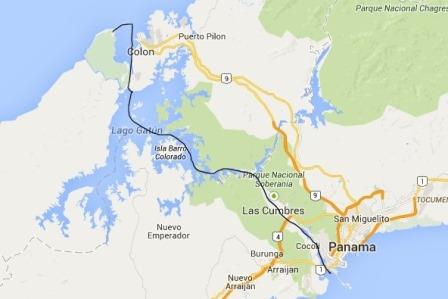
To give folks an idea for how long things take, we’ve included the hour by hour timing as the day progressed.
6am – The alarm clocks go off, and we all immediately regret having stayed up too late last night. Melissa starts up the coffee pot and we scramble to do a few last minute tasks such as hanging all the tires around the boat to ensure we don’t get damaged should we go bouncing around the lock. Melissa starts cooking breakfast and prepping the food for the day. We let go of the mooring and headed for the dock. Our plan had been to fill our water tanks before heading off, but unfortunately our timing was bad, so we had only enough time for Mike and Holly to hop aboard before the ferry started honking at us to get out of the way.
7am – We are in place floating around outside the channel waiting for our advisor to arrive. They radio to let us know he will be late. We finish up covering up the solar panel on top of the arch as a badly thrown monkey fist (more on that later) that lands on a solar panel can break it. Melissa serves up a breakfast of bacon, scrambled eggs with cheddar cheese and salsa, papaya, and mini croissants.
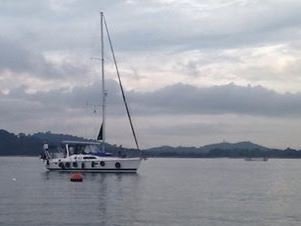
8am – Our advisor comes aboard. His name is Raphael. He is highly experienced and super friendly. He immediately set everyone at ease and had Captain Dave cracking up. Dave tells Raphael that he is captain, and that Mike is his co-captain. Raphael gives us a short briefing to tell us how the day was going to go. At least in theory because the only thing about a plan is that you know its going to change as events progress.

Photo courtesy Jim Maurer
9am – We started our run down the channel towards the first Miraflores lock. This is our “lock buddy” the Orient Transit. We transited the first three locks with them.

This is the dredger that goes up and down the canal all day long sucking silt off the bottom and then going out to sea to dump it. It has been driving us crazy because it zips back and forth at top speed creating a monster wake in the marinas and anchorages near Panama City. When it goes by you better hold on to your coffee cup.
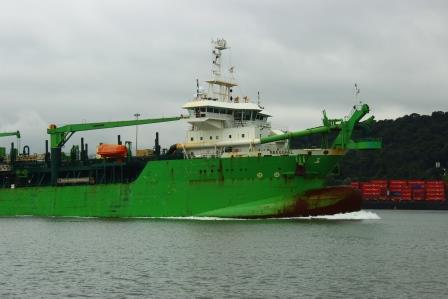
Everyone took time during the day to just sit and enjoy watching the show.


And everyone was snapping pictures like crazy. Melissa took 555, and between us we took 859 photos total.


10am – We enter the first lock.

We were supper happy that they planned to side tie us to a tugboat as this means we don’t have to take up the slack in our lines as the water level rises – the tug does all the work. So all we had to do was pull up alongside and tie up.
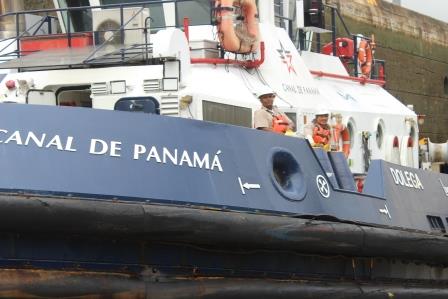
Dave eased up along side perfectly and then Mike and Jim tossed the tug our lines and pulled them tight.
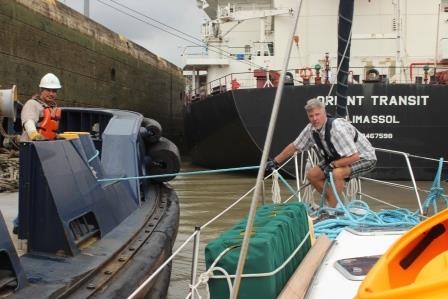
The advisor decided we should also have a spring line, and there was some last minute adjustment to the height of the tires to make sure that in the turbulence of the lock filling we wouldn’t damage the boat by rubbing against the tug.
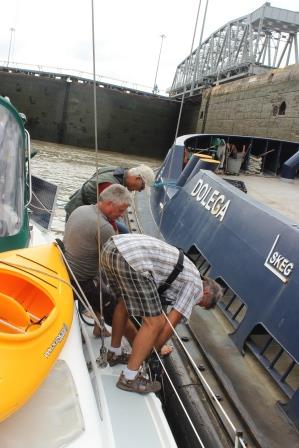
Then the big doors close.
And they start to flood the lock. Its crazy turbulent.
The turbulence continues when Orient Transit starts up her engines and begins to move forward.
Then it was onto the second lock. By then we knew exactly how to tie up to the tug. We passed them some fruit and mini croissants for the 4 crew aboard.
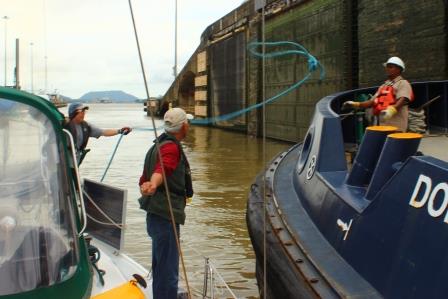

11am – As we left the second lock, we became visible on the lock webcam.

At one point the tug in front of us stopped suddenly and Dave had to maneuver to ensure we didn't run right into it.

No doubt there are tons of pictures taken of us from all the people on the observation deck as we passed through.

Our friend Rob on R&R Kedger made us this movie of clearing the lock. We are super excited and hope to see them tonight. With luck we will be able to travel to the San Blas Islands with them in a few days.
Then we crossed the Miraflores lake to the third Miraflores lock.
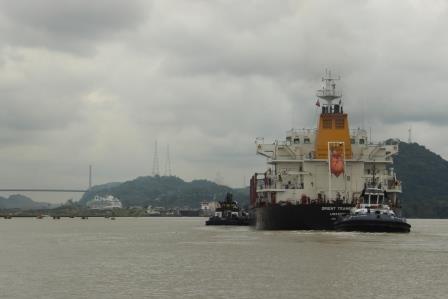
On our way into the third lock, we witnessed a huge argument between a couple of the workers. One was maneuvering something from a crane down to ground level. He was very upset. We couldn’t follow the rapid fire Spanish, but best guess is that a supervisor was furious over something a subordinate did and was hollering at him. It felt like maybe a "you might have gotten someone hurt" type of lecture.
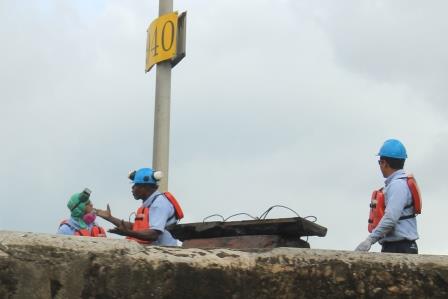
By the third lock everyone was relaxed and chatting.

Noon – We cleared the third lock and were in Lake Gatun. At this point a debate ensued about whether we would be able to make it across the lake in time to make our lock slot on the Atlantic side. It is 27 nautical miles, and normally we travel at 6 knots – which wouldn’t have gotten us across in time for our 4pm slot. So Dave decided to push the engine a bit harder than we normally would and go 6.8 knots. It is clear that Raphael would have given us the option to stay on the lake overnight had we wanted to. But it was our hope to make it in a day, so we decided to go for it. We later decided this was probably a mistake as we made our way into the marina in the pitch black (more on that later).
At this point it was time to relax for a while.

Photo courtesy Jim Maurer
We watched our tug speed by and begin maneuvering Orient Transit onto their mooring in the lake.
Then it was time for Melissa to start cooking lunch. A panini type sandwich with ham, provolone, and basil, a bacon-cheddar-broccoli salad, and a tomato-basil-feta cheese salad. Yum.
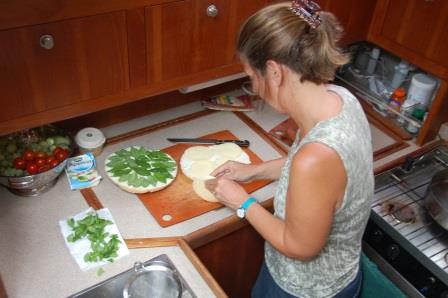
Photo courtesy Jim Maurer
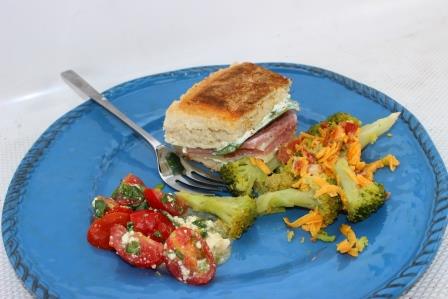
Lake Gatun is filled with islands. These are now being studied by scientists because when the lake was formed 100 years ago when the canal was built, these islands stranded a ton of wildlife that has now been isolated all this time. Its like a mini-Galapagos now in terms of isolated animal evolution.

In the middle of the lake there are a number of canal operations centers. One has this huge crane called Titan. It was purchased from Germany for $1. Originally built by Hitler to lift submarines, Panama bought it and spent $10 Million moving it to Panama and then refurbishing it. Getting it through the canal meant removing the rubber bumpers in the canal to make it fit.

Photo courtesy Mike Sanderson
As we crossed the lake we passed a lot of traffic headed the other direction. Everyone on this cruise ship was waving at us and taking pictures as we went past. If only we could find someone with one of those thousand pictures of us! (Melissa did a google search for images posted in the past 24 hours as "Panama Canal sailboat" but found nothing.)
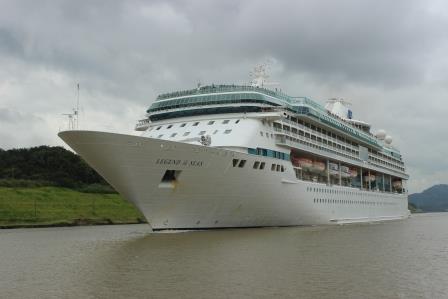
Probably the most interesting thing we saw was this lock door for the new locks being towed into place.

4pm – We dropped anchor right outside the Gatun lock to await our slot. It had started to pour rain, so Melissa put on her swimsuit to put down the anchor.
Melissa served up some snacks so that everyone would be well fueled for the next set of locks. Fruit, chips, hummus, cheese, and fresh brownies.

Photo courtesy Jim Maurer
After a bit, the big ship that was anchored nearby hailed us on the radio. They apparently didn’t like our anchoring position and thought that if they swung round on their anchor they might bump into us. Dave doubted this was true as he had intentionally anchored right next to a marker buoy, so if they were going to run into us, they would have to take out the buoy too. Oh well, by then it didn’t matter anyway because it was time for us to move into position for the lock. So Melissa goes out on deck and pulls up the anchor. She is a bit puzzled because when the 50 foot chain marker comes up and hence the anchor should be off the bottom, the anchor winch is still pulling pretty hard. The explanation becomes clear when the anchor gets to the top. We had snagged a huge log and hauled it up. Fortunately it dropped off by itself and sunk back to the bottom.
We move into position and become visible in the Gatun lock webcam. Their HD camera is not working, so we only got low resolution pictures.
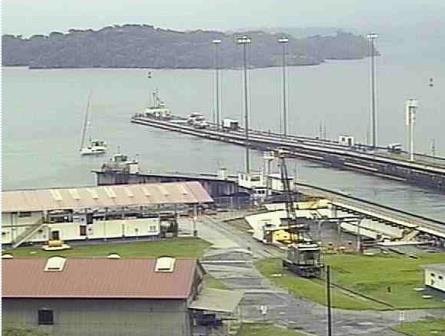
5pm – We approach the first Gatun lock and tie up along the port side where there is a small dock area.

One of the dock workers ties their line to our port side lines.

The workers on the other side then tossed the “monkey fist” across the lock towards us. The monkey fist is a ball about the size of a tennis ball. It lets them throw the line across to us and land it on the deck. Well, theoretically anyway. Raphael had explained that workers train for three months to learn to toss the monkey fist accurately. They practice by tossing it through a small opening in a big piece of wood till they can throw accurately. Alas it took three tries before they were able to get the monkey fist aboard our boat. The first throw fell short because the line got tangled. The second throw bounced off our bimini top and fell in the water. The third throw fell short.

The fourth throw they landed it on the deck, and Mike tied our line to theirs.
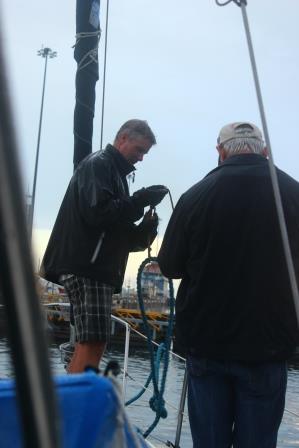
Then we watched our second “lock buddy” approaching. A giant car carrier called "Altair Leader".

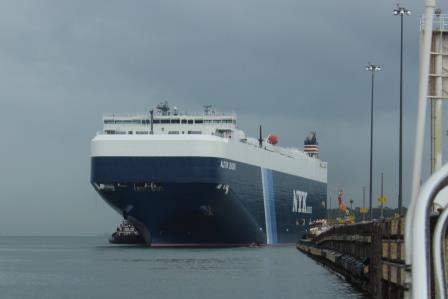
Then it was time to pull forward into the first lock. The workers held their line and walked down with us.

Once in position they pulled our big lines up onto the huge cleats.

Once we had all four lines in place, and we were centered perfectly in the lock, we watched the car carrier pull in behind us. Super intimidating to have this big boy bearing down on you. Melissa liked being behind the big ship in the first three locks much better. But Dave swears it’s better for us to be in front because we won’t be in their prop wash when they pull forward. Well, yeah, but let’s hope they don’t lose the breaks on the mules that are pulling it into position or we’re gonna be flat as a pancake.

As they let the water out, all four line handlers have a critical job – they have to let the rope out slowly. If the rope is cleated off and goes tight, it can “hang” the boat. We did that once in the French locks. What happens is that the rope can get so tight that you can no longer get it off the cleat to let it out. And at that point as the water continues to flow out of the lock, the line gets to the point where it is taking the full weight of the boat. At this point you can pull a cleat clean off the boat, or a rope can break. Either of which can cause serious injury if the rope or cleat hits someone. This happened on a Russian boat last year in the Panama Canal and a boat worker was killed when a line snapped and hit him in the face. So what we have been taught is that you should never actually cleat off the ropes, but just hold a wrap around the cleat and then hang on tight to the rope. But Raphael had everyone cleat off the rope except when it actually needed to be let out. This surprised us, but it’s possible he was more worried about someone accidentally loosening up the rope too much and sending us spinning in the strong currents.

Meanwhile, Dave used reverse thrust to keep us from moving forward towards the lock doors. Note that he isn't behind the wheel looking forward, he's sitting sideways so that he can watch whether we are moving forward or backwards relative to the lock wall.

Going down is much less turbulent in the lock as the water just drains away. After the doors open, the dock workers drop the lines off the cleats, and we reel them back on board, still tied to the dock worker small lines. That way the dock workers can continue to walk us down to the next lock. There are a number of obstacles on the walls though, so our line handlers have to hold the lines up high as we transition between locks.


There was a gorgeous light house as we entered the second lock and the sun was setting.
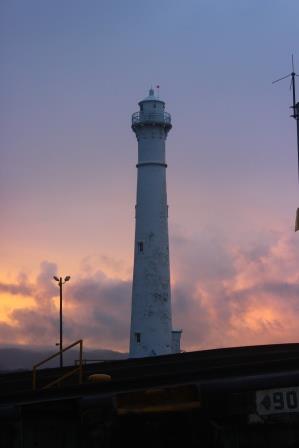
Then we repeated the process in the second lock. As we exited the second lock, the advisor asked Dave to slow down to allow the dock workers walking along side us time to come down the hill between the docks.

The problem with this was that there was still a lot of current rushing out of the lock. The current overtook us. On a sailboat, the rudder only works if there is water flowing over it. When you are moving forward, if you turn the wheel to port, the boat turns to port. When you are moving backwards, if you turn the wheel to port, the boat turns to starboard. If you aren’t moving through the water, turning the wheel does nothing. So as the current overtook us, Dave first lost steering control, and then the rudder reversed as the water rushed past us. The current was pushing the boat to starboard, and your first instinct is to turn to port to try and correct. But after a few seconds Dave realized that he had no steerage and said to Raphael, “I’ve lost the rudder”. Raphael didn’t understand and asked if the rudder had fallen off. No, Dave explained, he had no steering. Meanwhile we were continuing to turn sideways in the lock. Normally if you were in a strong current and this happened navigating around somewhere like the San Juan Islands, you would hit the throttle and speed up to get rudder control back. But a strong forward throttle would probably have put us straight into the lock wall. Moreover, we were still waiting for the lock workers to catch up with the boat and going forward fast would have potentially yanked the lines from them – causing a second problem – lines in the water that could get caught in the prop. Here is how close we were to the wall at this point:
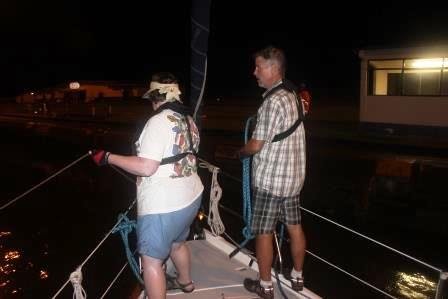
Raphael was giving Dave instructions, but Dave just shut him out at that point and hit full reverse. That way the current rushing past and the throttle in reverse were working together to give him water flow past the rudder so he would get steering back. He quickly got the boat back under control and centered straight in the lock. Once he explained to Raphael what happened, Raphael said, “Nice job captain. Good decision making.”.
The advisor's job is to inform the captain about lock operations. The captain's job is to safely pilot the boat. As Raphael said, "We know the locks, you know your boat". The problem with this situation was that the only way to have prevented us from getting sideways in the lock would have been to wait to exit the lock until the current had sufficiently dissipated. And since we had never been through the lock before and weren't familiar with just how much current would be there for how long, Dave moved forward when the advisor told him to. But the advisor (who may never have been at the helm of a sailboat in these conditions) didn't realize without bow or stern thrusters that physics would take over with as much current as we had.
We got positioned in the final lock. At this point one of the dock workers yelled over and asked if they could have some sodas. We were happy to give them some pop, but weren’t sure how to get it over to them. Simple, they tossed over another monkey fist and we put the pop in a bag and tied it to their line. They pulled the bag full of pop back over to the side. Raphael was super embarrassed about them asking for the sodas, but we were happy to give it to them!

And then… the doors open to the Atlantic…
Time to pop open a bottle of champagne!
7:30pm – We dropped off our advisor aboard one of the pilot boats, and headed for the marina. Dave asked Mike to study the approach to the marina so that both of them could make sure we were headed the right way. It was pitch black and there are blinking red, green, and yellow marker buoys everywhere amongst the ships waiting to transit the canal the other direction. Figuring out which ones we were supposed to be following in the narrow channel between the breakwater and the shoals so we don’t run aground was tricky to say the least. The map below shows how narrow the channel is. The red boat is showing is where we docked in the marina. As we entered the channel, Mike spotted a green buoy with its light out. He hollered to Dave, "Hard to port" and Dave swung us around without questioning the instruction and we narrowly missed running right into the dark buoy. Then the depth started to drop off rapidly. At one point the depth dropped to 4.3 feet below our keel. It was incredibly nerve wracking! (The next day the marina owner told us he thought a buoy must be out of place.) Then Mike spotted a second buoy with its light out and we steered around it. Thank goodness for Mike’s great night vision. And super good teamwork between the guys.

Finally we came through the marina entrance. Rob on R&R Kedger had been IM’ing with Melissa. Rob got us our slip assignment and said that everyone would meet us at the dock with flashlights as the marina wasn’t very well lit. We had our spot light out and were lighting up the boats and piers so that Dave could slowly make his way in the dark. Rob had told us that they would be on the end of “D” dock lighting up a boat called Pegasus (a boat we all know well) which is where we were supposed to turn. And indeed as we made the final turn down D dock, we could see a crowd of people there to meet us all waiving flashlights so we could see where Pegasus was located. Without our friends lighting our way, we might not have wanted to steer towards what looked like bushes and land off to our port side. We slowly made our way down to D dock and made the right turn towards our slip.
Dave had elected to back into the slip to make getting on and off the boat easier. So easy as you please he backs it onto the dock, Melissa tosses the stern line down to the waiting crowd. Mike hops off with the bow line. And just like that, we are safe, snug and secure at the dock. One of the other cruisers said laughingly, “show off!” We haven't been in a marina since June 29th. We've either been at anchor or on a mooring since then. Nice to be someplace that we don't have to deploy the flopper stoppers!
Yep, Captain Dave has brought us safely to El Caribe.
